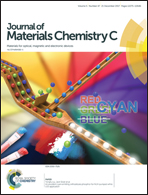Ultrasensitive detection of explosives via hydrophobic condensation effect on biomimetic SERS platforms†
Abstract
3D biomimetic superhydrophobic Ag micro/nano-pillar array (AMA) surfaces as SERS substrates were prepared for ultrasensitive and reproducible detection of explosives such as picric acid (PA) and 3-nitro-1,2,4-triazol-5-one (NTO) by a simple, efficient, and inexpensive hydrophobic condensation strategy. We took advantage of different kinds of Si pillar arrays (biomimetic structure based on cicada wing topography) as templates for electrochemical deposition generation of 3D AMA. We studied the effects of biomimetic superhydrophobicity and different AMA micro-morphology on SERS performance from a macro and micro perspective, respectively. For the first time, simple hydrophilic organic synthesis process was also conducted to improve poor water-solubility of toxins to aid detection. Such SERS sensors exhibited high sensitivity to rhodamine 6G (R6G) in a low concentration of 10−15 mol L−1, PA in a low concentration of 10−12 mol L−1, and NTO in concentration as low as 10−13 mol L−1 after hydrophilic synthesis. This method of hydrophobic condensation of substrates resolved the problems for extremely low concentration of organic solutions of toxins in difficulty to SERS detection. Furthermore, it was found to be very useful to improve practical application of portable Raman detection devices to detect low-solubility protonic toxins.



 Please wait while we load your content...
Please wait while we load your content...